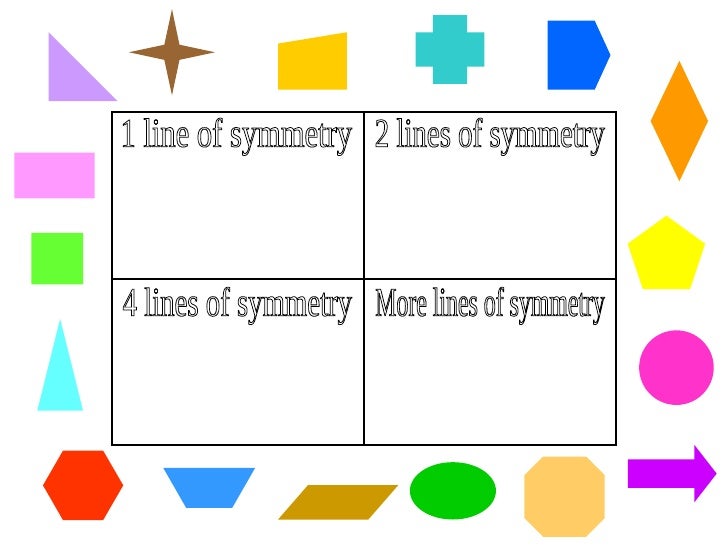

When a shape or pattern is reflected in a line of symmetry or forms a mirror image, then it is considered to show a line symmetry. How many lines of symmetry does an isosceles triangle haveįAQs on Line Symmetry What is Line Symmetry in Geometry?.For a parabola with quadratic equation y = ax 2 + bx + c, line of symmetry is x = -b/2a.A figure can have one or more lines of line symmetry depending on its shape and structure.Line symmetry can also be observed on inkblot paper.An object and its image are symmetrical with respect to its mirror line.All regular polygons are symmetrical in shape.So, the given parabola has a line of symmetry x = -1/2. Solution: Identify a, b, c in the given equation. Let us solve an example to understand it better.Įxample: Find the line of symmetry of parabola y = x 2 + x - 5 The line of symmetry equation is given by, x = -b/2a. For a parabola with quadratic equation y = ax 2 + bx + c, the line symmetry equation is of the form x = n, where n is a real number. In coordinate geometry, a parabola has a line symmetry and its line of symmetry passes through its vertex. Since an infinite number of lines can be drawn inside a circle passing through its center, therefore a circle has an infinite number of lines of symmetry. The two diagonals of the rhombus form its lines of symmetry. Line Symmetry in RhombusĪ rhombus has two lines of symmetry. If a triangle is isosceles, then it has at least one line of symmetry, and if the triangle is equilateral, then it has three lines of symmetry. If a triangle is scalene, then it has no line symmetry. The line symmetry in a triangle depends upon its sides. So, a rectangle has just 1 vertical and 1 horizontal line of symmetry. When a rectangle is folded across its diagonals, the shape is not symmetrical. Line Symmetry in RectangleĪ rectangle has two lines of symmetry, that is lines through the midpoints of opposites sides. So, a square has 1 vertical, 1 horizontal, and 2 diagonal lines of symmetry. Some of the common examples of the line of symmetry in two-dimensional shapes are given below: Line Symmetry in SquareĪ square has 4 lines of symmetry, which are lines through the opposite vertices, and the lines through the midpoints of opposites sides make up the four lines of symmetry. We have plane shapes in geometry that have line symmetry such as square, rectangle, triangle, rhombus, parallelogram, etc. A diagonal line of symmetry divides a shape into identical halves when split across the diagonal corners. In such a case, the line of symmetry is diagonal. Diagonal Line of Symmetry: In the above shape, it can be noticed that the shape can be split across the corners to form two identical halves.Hence, the horizontal line of symmetry divides a shape into identical halves, when split horizontally, i.e., cut from right to left or vice-versa. In such a case, the line of symmetry is horizontal. Horizontal Line of Symmetry: In the above shape, it can be noticed that the shape can be split into two equal halves when cut horizontally.In such a case, the line of symmetry is vertical. Vertical Line of Symmetry: In the above shape, it can be noticed that the shape can be split into two identical halves by a standing straight line.The line of symmetry can be categorized based on the basis of its orientation as: Observe the different patterns of the line of symmetry an object can have with the help of a given figure. This line of symmetry is called the axis of symmetry. When a figure is folded in half, along its line of symmetry, both the halves match each other exactly. Here, we have a square and we can fold it into two equal halves. The line of symmetry also known as a mirror line is a line that divides an object into two identical pieces.

It is known as mirror symmetry because for the two halves which are symmetrical, one of them follows lateral inversion. Thus, a shape has to have at least one line of symmetry to be considered as a shape with line symmetry or mirror symmetry. Imagine folding a rhombus or square along each line of symmetry and each of the half matching up perfectly, then this is symmetry. The very first thing to check is that the object tends to have a reflection of one-half. Let us now see how a line symmetry is represented. So, a line of symmetry can be considered as an imaginary axis/line which divided a figure into two identical halves. The line of symmetry can be in any direction - horizontal, vertical, slanting, diagonal, etc. When there is at least one line in an object that divides a figure into two halves such that one-half is the mirror image of the other half, it is known as line symmetry or reflection symmetry. Line symmetry is a type of symmetry about reflections.


 0 kommentar(er)
0 kommentar(er)
